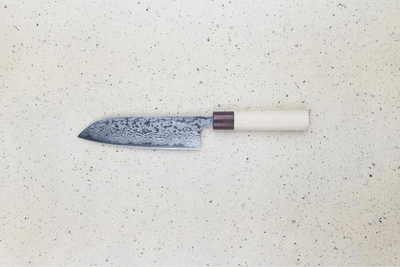Santoku v.s. Gyuto - The Best Multipurpose Kitchen Knife
Or: Clash of the Titans: The Re-clashening
Part 2: The Quickening
I have a lot of knives. I have knives for vegetables, knives for meat, knives for boning, knives for fish, knives for sushi, knives for peeling, knives for turning, knives for rotary cutting, knives for octopus, knives for chicken, knives for brisket. You name it, I’ve got a knife for it. I love knives! However, putting this collection together took time. Where does one begin? How do you decide which shape to start with? Perusing the pages of knifewear.com can be a little intimidating, so let’s narrow it down just a scooch.
I always suggest folks get the ball rolling with something versatile. Something that can be used on the daily for almost every task in the kitchen. So, which is the most versatile knife? Well, there are actually two. Let’s take a look at…

Santoku v.s. Gyuto
These two shapes are easily the most versatile kitchen knives. They both share some pretty important features: they’re tall enough that they keep your knuckles off the cutting board, they’re long enough that you can use a slicing (rather than chopping) motion, and they have a pointed tip. However, they are quite different in some pretty key areas. Let’s start with the...

Santoku
Santoku means “Three Virtues” in Japanese. Many say dicing, slicing, and mincing, but the idea of 'three virtues' just means it can do a bit of everything. This knife is a workhorse! The actual shape of the blade makes it ideal for the majority of household tasks.
It’s typically a little bit on the smaller side - often between 150mm and 180mm - making it a less intimidating option than the Gyuto. Notice how the sharpened edge is quite flat and how low the tip of the knife comes down towards the cutting board? A nice flat knife means that full, clean contact against the cutting board is easy, making it ideal for quick chopping of veggies and herbs. The tip can be used for a variety of tasks that require more articulation, like coring the stem out of a cauliflower, or trimming a bit of excess fat off a pork tenderloin.
I consider the santoku a multi-purpose and easy-to-wield knife, biased towards chopping vegetables. Its size and shape make it the ideal choice for most casual home cooks. Professional chefs who do a great deal of chopping and prep will also find this tool super handy, but I feel they should also take a peek at the...

Gyuto
Gyuto is Japanese for “cow sword”. In my professional opinion, this is the most badass name for any knife shape. COW SWORD. So rad. However, this name is just as misleading as it is cool. While the gyuto is indeed quite proficient for processing beef, it’s capable of so much more.
Gyuto knives come in a huge variety of sizes. I’ve seen them as short as 150mm, and as long as 330mm, but the most typical dimensions are between 210mm and 240mm. Due to their length, they’re better for cutting large or dense food that may require a lot of sawing if you’re using a shorter blade. More knife = more efficient cutting and less sawing back and forth. Whether you’re slicing a fish or a turkey, or blasting through squash or sweet potatoes, the gyuto has got you covered. The shape of the tip is a bit different than the santoku - notice how the tip doesn’t drop down towards the cutting board as much as the santoku’s because the sharpened edge curves up away from the cutting board. This gives the blade an articulate and pronounced pointy tip, making it a much more effective tool for delicate tasks like cleaning fat and silverskin from meats.
While the length may be intimidating to some, I personally feel like the gyuto is the most versatile blade in the kitchen, especially ones that are around the 240mm mark. Initially, it may feel a little unwieldy or even clumsy when approaching smaller chopping tasks, but with some practice, it is the ideal tool for professional cooks and the serious amateur who loves cooking.

How do I choose the right knife?
Looking to up your knife game in your home kitchen and wanna dip the toe into Japanese knives? Get a santoku. The very first kitchen knife I got while attending culinary school was a santoku, and look at me now - I’m livin’ the dream, baby! Seriously though, santoku knives are perfect for almost any cook. Even if you’re a certified pro, having a nice simple santoku with you in the prep hall or on a busy line can make all the difference in the world.
Looking to do some serious cooking? Chopping onions and making brisket on the same day? Want the same knife to be able to do nearly every job in the kitchen? Cutting up a lot of steaks? Get a Gyuto - preferably a longer one.
If you’re reading this because you’re choosing your first Japanese knife, I recommend that you take the time to care for your knife properly. Regardless of which you choose, a ceramic rod and strop to keep it sharp, and a blade guard, magnet, or saya will keep it safe. Also, a proper cutting board helps keep things tidy, and won’t dull your knife. Happy chopping!







